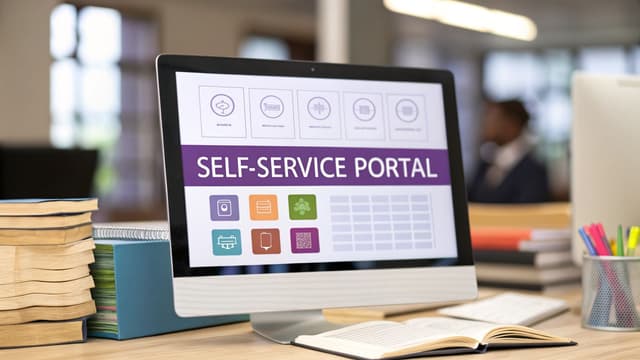The Evolution of Customer Support Automation

The infographic above illustrates the positive impact of automated customer support across several key performance indicators. Implementing automation can result in a 30% increase in customer satisfaction, a 40% reduction in support costs, and 50% faster resolution times. For a comprehensive overview of workflow automation for small business, explore our workflow automation for small business guide.
These significant improvements demonstrate how automated customer support has evolved from a simple cost-cutting measure into a automation strategies for enhancing the overall customer experience by leveraging workflow automation for small business. For small businesses looking to streamline their processes, explore our guide on workflow automation for small business. This shift is fueled by increasingly sophisticated AI-powered tools and a growing customer demand for quick and efficient support.
From Basic Chatbots to Intelligent Assistants
Early customer support automation often relied on basic chatbots – learn about different types of chatbots. These chatbots offered pre-written responses to a limited number of questions. This often led to customer frustration due to the systems' inability to handle complex inquiries or understand the nuances of natural language.
However, advancements in Artificial Intelligence (AI) and Natural Language Processing (NLP) have paved the way for the development of intelligent assistants. These assistants can understand and respond to a much broader range of customer needs.
For example, AI-powered chatbots can now analyze customer data to offer personalized recommendations. They can also proactively offer support based on predicted needs and seamlessly escalate complex issues to human agents. For a deeper look into automation solutions, check out this article on automating customer support.
The Rise of AI and its Impact on Customer Support
The widespread adoption of AI is reshaping how businesses interact with their customers. Over 67% of consumers worldwide have used a chatbot for support in the past year. This indicates a growing acceptance of automation in customer service.
Furthermore, 51% of consumers actually prefer using bots for immediate assistance, highlighting the importance of instant responses. This trend is expected to grow, with projections indicating AI will handle 95% of all customer interactions by 2025. Learn more about the impact of AI in customer support here.
This rapid growth underscores the strategic importance businesses are placing on automating their support processes. You might also find this article helpful: How to master customer support automation.
Automation as a Competitive Advantage
In today's competitive business environment, companies that embrace automation are gaining a significant edge. Automating routine tasks and inquiries frees up human agents to focus on more complex issues and provide personalized support.
This not only improves efficiency but also increases customer satisfaction and loyalty. Additionally, automation enables businesses to offer 24/7 support, expanding their reach and serving customers across different time zones through multilingual customer service. This constant availability has become a key differentiator for businesses striving to provide exceptional customer experiences. Learn more about the benefits of using AI chatbots for business growth.
Implementing AI Chatbots That Actually Work

Let's face it: many chatbot implementations fall short of expectations. This section explores the key ingredients for building truly effective AI chatbots for real-world customer support. Instead of chasing the newest fads, we'll focus on choosing the right solution for your business.
Designing Natural Conversation Flows
A successful chatbot hinges on its ability to engage in natural-sounding conversations. This begins with carefully designed conversation flows. These flows should mirror human interactions, anticipating customer questions and providing helpful responses.
For example, a chatbot could start by greeting the customer with a personalized welcome message. Then, it could offer assistance with common issues. This creates a more user-friendly experience.
Creating A Chatbot Personality
Your chatbot's personality should align with your brand. Whether it's friendly and casual or professional and informative, consistency is key. This helps build rapport with customers.
Consider your target audience and their communication style. A chatbot for a tech company might use more technical terms. A chatbot for a children's clothing store, however, might use a playful tone. A consistent personality helps build trust and engagement.
Building An Effective Knowledge Base
A robust knowledge base is essential. It empowers your chatbot to answer a wide array of customer questions. This resource should be comprehensive, up-to-date, and easy to search.
Organize your knowledge base into logical categories, using clear and concise language. This allows the chatbot to quickly access and retrieve the right information, ensuring accurate and timely support.
Before we discuss human handoff, let's look at a comparison of various AI chatbot implementation approaches. This will provide context for choosing the best fit for your needs.
To help you choose the right implementation approach, here's a comparison table outlining various options:
AI Chatbot Implementation Comparison This table compares different approaches to implementing AI chatbots for customer support, helping businesses choose the right solution based on their needs and resources.
| Implementation Type | Setup Complexity | Cost Range | Best For | Limitations |
|---|---|---|---|---|
| Custom-built platforms (e.g., Dialogflow) | High | Varies significantly, typically higher | Businesses with very specific needs and technical expertise | Requires substantial development resources and ongoing maintenance |
| Chatbot building platforms (e.g., Chatfuel) | Medium | Moderate | Businesses with moderate customization needs and some technical skills | Can be limited in flexibility compared to custom platforms |
| Pre-built chatbot solutions (e.g., Intercom) Intercom chatbot pricing guide | Low | Low to Moderate | Businesses needing basic chatbot functionality quickly | Limited customization options, may not meet complex needs |
As you can see, different chatbot solutions offer varying levels of complexity and customization. Choosing the right approach depends on your specific needs, resources, and technical expertise.
Seamless Human Handoff
Even the best chatbots can't handle every scenario. Knowing when to bring in a human agent is critical. Complex or sensitive issues often benefit from a human touch.
Implement a smooth handoff process to maintain context and prevent customer frustration. For instance, if the chatbot detects rising customer frustration, it should seamlessly transfer the conversation to a live agent.
Measuring Chatbot Performance
Track key metrics to ensure your chatbot is effective and improves customer satisfaction. Metrics like first contact resolution rate, average handling time, and customer satisfaction scores offer valuable insight.
These metrics allow you to continually refine your chatbot's performance, ensuring your automated support consistently delivers value. By focusing on these core elements, you can build AI chatbots that truly automate customer support and improve the customer experience.
Transforming Support Workflows With Automation

Automating customer support goes beyond simply using chatbots. It involves optimizing the entire support process, from initial contact to resolution and follow-up. This improves both the customer and agent experience. Leading companies are redesigning their processes with this comprehensive approach in mind.
Mapping Workflows for Automation Opportunities
The first step is to map your current processes. This means documenting every step in the customer journey, from the initial contact to the final resolution. This creates a clear understanding of where automation can be most effective.
Identifying high-impact automation opportunities often involves finding bottlenecks. These are areas where agents spend significant time on repetitive tasks. For example, manually routing tickets or automate data entry are prime candidates for automation and these efforts help reduce support tickets.
Implementing Solutions to Eliminate Bottlenecks
After identifying key areas for improvement, businesses can implement solutions for their specific needs. This could include intelligent ticket routing, automated priority assignment, or automating other repetitive tasks.
This frees agents to handle complex issues and build customer relationships. Automation also improves accuracy, reducing manual errors. These changes create a better support experience for everyone. The development of support automation is impacting global contact center operations. Find more detailed statistics here. You might be interested in: How to improve customer satisfaction.
Real-World Implementation Stories and Overcoming Challenges
Many organizations have successfully automated workflows with excellent results. These real-world examples offer valuable insights into the challenges and benefits of automating customer support. They also provide practical advice for other businesses.
One common hurdle is managing change and getting team buy-in. Successful implementations often involve thorough training and open communication with support teams. This helps agents understand the advantages of automation and feel comfortable with new tools and processes. These automated workflows lead to measurable improvements in resolution time and customer satisfaction. Automating repetitive tasks allows teams to be more efficient and focus on delivering better support.
Building Self-Service Resources Customers Actually Use
Many knowledge bases go unused, piling up support tickets. This disconnect happens because customer desires (self-service) often don't align with what businesses offer. This section explores bridging that gap, creating resources customers actually use, and automating customer support.
Understanding Customer Psychology
Effective self-service begins with understanding customer thinking. They want fast, simple answers. A recent study revealed 70% of customers prefer using a company website for answers instead of phone or email. This highlights the vital role of easy-to-access self-service options.
Consider how customers search. They use straightforward language and specific keywords. Your content should be easy to grasp and optimized for relevant search terms.
Creating Helpful Content
Knowledge base content should anticipate customer needs. Go beyond basic product feature documentation. Address common problems and provide solutions.
For instance, instead of just explaining password resets, include troubleshooting for common reset issues. This proactive approach saves customers time and frustration. Explore customer experience automation for more on automating aspects of customer experience.
Structuring Information Effectively
Organize your knowledge base logically for customers. Use clear categories, descriptive titles, and a sensible hierarchy, ensuring they find information quickly.
Use diverse formats like text, images, and videos for various learning styles. A well-structured knowledge base reduces customer support contacts.
Maintaining Fresh Content
Keeping your knowledge base current is essential. Outdated information creates confusion and more inquiries. Implement a regular review and update process.
Assign ownership of sections to team members for accountability, preventing stale content. Regular updates maintain the relevance and value of your self-service resources.
Implementing AI-Powered Search
Modern knowledge bases often utilize AI-powered search. Customers find relevant information quickly, even without exact keywords.
This intelligent search enhances self-service, reducing customer effort and boosting satisfaction. It’s key for automating customer support effectively. A good AI-powered search can significantly decrease support tickets.
Measuring Self-Service Effectiveness
Measure which self-service resources work best. Track metrics like ticket deflection rate and knowledge base usage.
This data reveals which resources truly help customers and identifies improvement areas. Analyzing this data optimizes self-service resources and maximizes effectiveness.
Creating the Perfect Human-AI Support Partnership

The most effective automated customer support isn't about replacing human agents; it's about empowering them. This section explores how leading organizations are forging strong partnerships between AI and their support teams. This collaborative approach helps businesses automate routine tasks effectively while preserving the essential human element of customer care.
Identifying Tasks for Automation vs. Human Intervention
The foundation of a successful human-AI partnership lies in recognizing which tasks are best suited for each. Routine inquiries, such as order status updates or password resets, are ideal candidates for AI-driven automation. This frees up human agents to focus on more complex issues.
On the other hand, situations requiring empathy and nuanced understanding, such as handling complaints or resolving complex technical issues, are best handled by human agents. This strategic division of labor maximizes efficiency and improves overall customer satisfaction.
Designing Seamless Handoffs
Creating a smooth transition between AI and human agents is critical. Customers should never feel like they're being shuffled around. The handoff needs to be seamless and maintain the context of the conversation.
For instance, if an AI chatbot, like those powered by ChatGPT, encounters a complicated issue, it should seamlessly transfer the interaction to a human agent, along with all the relevant information. Clear communication during this handoff is vital, keeping the customer informed and minimizing confusion. This ensures a consistent and efficient support experience. The increasing adoption of AI in customer service is reshaping how businesses engage with their clientele. You can explore emerging AI trends in customer service to learn more.
Empowering Agents with AI Assistants
AI assistants can significantly enhance agent performance. These tools provide real-time access to knowledge bases, offer suggested responses, and even manage routine aspects of more involved conversations. This allows agents to dedicate their full attention to the customer's unique needs.
By handling these tasks, AI assistants empower agents to address more complex problems, deliver faster solutions, and build stronger customer relationships. They become invaluable partners, boosting agent productivity and elevating the overall quality of support.
Addressing Job Displacement Concerns
Integrating AI into customer support often sparks concerns about potential job displacement. However, many companies are adapting by redefining agent roles to concentrate on higher-value interactions. Rather than replacing agents, AI is augmenting their capabilities.
This shift allows agents to focus on tasks that demand empathy, critical thinking, and problem-solving skills. It also creates opportunities for agents to develop new skills and assume more strategic positions within the support team. This approach benefits both the business and the employees, providing more engaging and fulfilling work for the agents.
FlowGent AI: Your Partner in Human-AI Support
FlowGent AI helps businesses create this ideal human-AI partnership. Our platform enables you to deploy intelligent AI agents that seamlessly integrate with your existing team. This empowers your agents to tackle complex issues, provide prompt solutions, and cultivate stronger customer relationships.
Personalizing Automated Support at Scale
Personalizing automated support is no longer a luxury, but a necessity. Leading brands understand that blending automation with a personal touch creates a truly exceptional customer experience. This is the key to automating customer support effectively. Let's explore how you can use customer data ethically to create helpful and engaging interactions.
Leveraging Customer Data Ethically
Personalization begins with data, but responsible use is crucial. Building trust with your customers means being transparent about the data you collect and how you use it. Respecting customer privacy while simultaneously using data to improve their experience is a delicate balance, but vital for long-term success.
For instance, if you're leveraging purchase history to recommend products, be upfront with your customers. Give them control over their data and preferences. Transparency builds confidence and strengthens the customer relationship. For more in-depth information on scaling customer support, check out our guide on How to master scaling customer support.
Dynamic Content Generation
Dynamic content generation tailors the support experience to each individual customer's needs. This doesn't require massive resources. Even small changes can make a significant impact.
Consider a customer contacting support after a recent purchase. An automated system, recognizing their purchase history, could offer tailored support options specific to that product. This targeted approach delivers more efficient and satisfying support.
Implementation for All Business Sizes
Personalizing automated support is within reach no matter the size of your business. Small businesses can begin with simple personalization strategies. Larger companies can develop more complex systems that learn and adapt from each interaction.
A small e-commerce business, for example, might personalize automated email responses based on recent purchases. Larger businesses could utilize AI tools like ChatGPT to analyze customer behavior and anticipate future needs.
Personalization Techniques in Automated Support
The table below illustrates several personalization techniques that can be implemented in automated customer support systems. It highlights their impact on customer satisfaction and the complexity of implementation.
| Personalization Technique | Customer Satisfaction Impact | Implementation Complexity | Data Requirements | Best Use Cases |
|---|---|---|---|---|
| Personalized greetings (using customer name) | Moderate | Low | Customer name | Chatbots, email |
| Product-specific support (based on past purchases) | High | Medium | Purchase history | Chatbots, email, self-service portals |
| Proactive support (anticipating future needs) | High | High | Customer behavior data, purchase history, etc. | Chatbots, email |
| Location-based support (offering relevant information based on location) | Moderate | Medium | Location data | Mobile apps, websites |
This table clearly shows that even simple techniques, like personalized greetings, can positively affect customer satisfaction with minimal implementation effort. More advanced techniques, such as proactive support, offer significant benefits but require more complex implementation and data analysis.
Measuring the Impact of Personalization
The advantages of personalization extend beyond customer satisfaction. It directly influences your bottom line. Personalized experiences can lead to significant improvements in key metrics. For instance, businesses have observed a 20% increase in resolution rates and a 15% decrease in customer effort scores.
This translates into increased customer loyalty and higher revenue. These outcomes emphasize the importance of treating automation as an ongoing process. Continuously refine and adapt your strategies to best serve your ever-evolving customer base. By focusing on data-driven personalization, businesses can fully realize the potential of automated support and build stronger customer relationships.
Measuring What Matters: Automation ROI Beyond Cost Savings
Too often, businesses focus solely on cost reduction when implementing customer support automation. This narrow view misses the bigger picture of how automation can positively impact the entire organization. This section provides a framework for measuring the true return on investment (ROI) of your customer support automation strategy, drawing insights from CX leaders on connecting key performance indicators (KPIs) to valuable business outcomes.
Beyond Cost Reduction: The Broader Impact of Automation
While cost savings are certainly important, they are only one piece of the puzzle. Automating customer support opens doors to improvements in various areas, such as faster response times, higher customer satisfaction, and increased agent productivity.
For instance, businesses that automate support frequently see a significant decrease in resolution times. This can lead to happier, more loyal customers. Furthermore, by handling routine tasks, automation frees up human agents to tackle complex issues and build stronger customer relationships.
Key Metrics for Measuring Automation Success
Choosing the right KPIs is crucial for understanding your automation's performance. A sole focus on cost savings overlooks valuable data. Metrics like First Contact Resolution (FCR), Average Handling Time (AHT), and Customer Satisfaction (CSAT) scores provide a more holistic view.
FCR shows how often issues are resolved on the first interaction. AHT measures the time taken to handle inquiries. CSAT scores gauge customer satisfaction with the support received. Tracking these metrics offers a balanced view of operational efficiency and customer experience quality.
Connecting KPIs to Business Outcomes
The most impactful metrics directly relate to business outcomes. Executives want to understand how automation affects the bottom line. Linking your KPIs to tangible results demonstrates the value of your automation strategy.
For example, a decrease in AHT can translate to lower operating costs and greater agent productivity. Improved CSAT scores can correlate with higher customer retention and increased lifetime value. By highlighting these connections, you can showcase the value of automation in a way that resonates with business leaders.
Ongoing Optimization Through Data and Feedback
Automation isn't a set-it-and-forget-it solution; it's a continuous process. Regularly review performance data, analyze customer conversations, and identify areas for improvement. Techniques like drop-off analysis can help pinpoint problems in your automated workflows.
Drop-off analysis reveals where customers abandon the support process, indicating potential shortcomings in your automated system. Integrating voice-of-customer (VoC) feedback can deepen your understanding of customer preferences and pain points.
Building a Roadmap for Continuous Improvement
Approach automation as an evolving capability. Continuously refine your strategy based on data and customer feedback to ensure your systems meet changing expectations. This includes adapting your automated workflows and incorporating new technologies.
This proactive approach keeps your automated support effective and relevant, delivering a consistently positive customer experience. By continually optimizing and adapting, your automation strategy becomes a key driver of customer satisfaction, operational efficiency, and overall business success.
Boost your customer support with FlowGent AI. Our no-code platform lets you deploy intelligent AI agents across various channels, offering seamless and efficient support 24/7. Visit FlowGent AI today to learn more.



